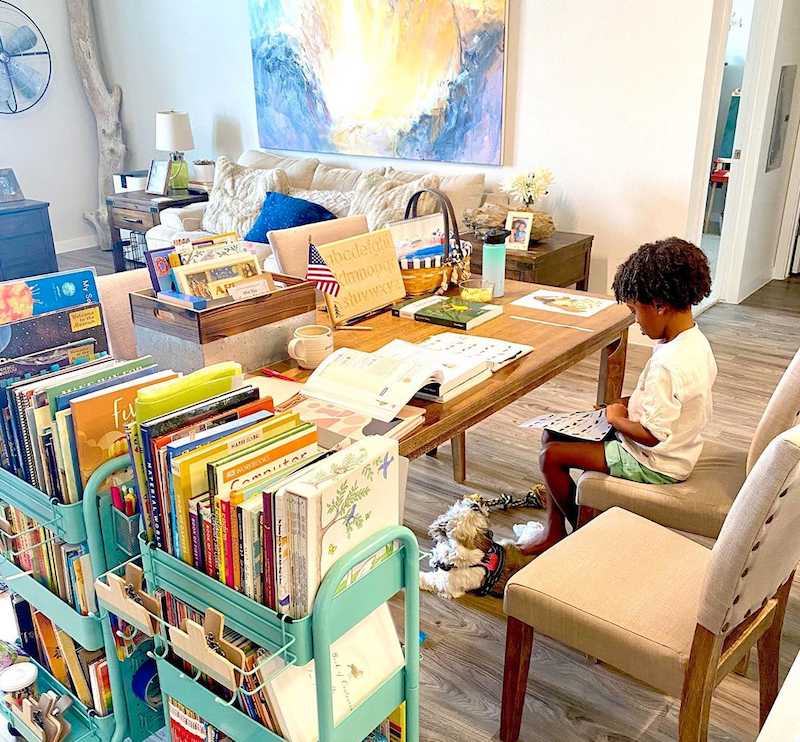
With schools turning to online learning and so many people opting to keep their kids at home, we wanted to get guidance from the amazing experts who do it every day—homeschool moms. We’re sharing insights from Shanell Eden of Two Lights Academy is a homeschool mom to her 6-year-old, Sprout. Here’s what her typical day looks like, her philosophy on picking materials, and answers to some practical FAQ.
How Do You Structure Your Day?
I like to talk about ‘rhythm’ versus ‘time frame’ because part of learning is being flexible and adapting to our kids and how they respond. My rhythm looks like this:
-
We start with relaxation: For us, that’s yoga and meditation.
-
Then we go into ‘Morning Magic’ (some call it ‘Morning Basket’): It’s a collection of topics from character building to art appreciation to nature study to reading aloud.
-
From here we enter into ‘Core Curriculum’: The 3 topics we cover every day are: Reading, Math, and Language Arts. Other topics we rotate such as Spanish, geography, and geology.
-
We always end with independent reading: I grab a book I want to read. He grabs a book he wants to read. And we’ll sit down to calming music and read together.
These activities usually fall between 10 a.m. and extend no later than 3 p.m. The most important thing is to be observant of my Sprout. If he is starting to get tired or needs a break, we take a break with 15 minutes of free play before jumping back into our studies. It’s very important to me that he is happy, enjoying learning, and doesn’t feel overwhelmed.
How do you pick (or make) homeschool materials?
So many people know that each child is different and that they should observe, listen, and adapt to their child. Yet still, when it comes to schooling, they expect a list of ‘best materials.’ We really believe that it is important to follow your child and understand his or her learning style. For my Sprout, he learns through rich literature and stories. Others are audio listeners or visual learners. Knowing my Sprout loves stories, I focus on trying to find materials that enable him to learn subjects through stories—versus worksheets or memorization.
For example, with math, the ‘curriculum’ I follow is called “Singapore Math.” But to learn the concepts, I will bring out storybooks that have math concepts in them. I’ll also bring out our SumBlox, so he has hands-on activities to make him feel like he is both playing and learning.
As another example, teaching a foreign language is really important to me, and he was really interested in Spanish. We want him to be fluent, but we’re not fluent. So it was important for us to have something that allowed him to hear the words in the accent but also be hands-on, in a multi-sensorial experience. That’s why when I saw the Habbi Habbi books, I thought, “I have to have them in my home.” We love them so much.
Independent Learning or Guided Learning?
A lot of parents ask if their kids can learn independently, or whether I’m sitting there with him. For the most part, I am there because I like to observe, answer questions, or unblock an exercise. But of course, there are blocks like independent reading or certain exercises where I can start him off, and he can work relatively independently—while I go make lunch or start a load of laundry.
I also write everything out in our planner. That way, he can look at it and see how our day is going to flow.
How Do You Keep “on Track”?
People ask this a lot, and it can be very sensitive. But I turn to two sources. One is Rebecca Rupp’s book Home Learning Year by Year, which lays out—from preschool to high school—exactly what children learn at every single grade level. The other is the HSLDA website for each state. They will let you know what your state recommends. I look at these two sources and just make sure we’re on track and ahead of the curve.
What’s Your Most Important Tip When It Comes to Homeschooling?
A lot of parents feel nervous about starting, and I always tell them—no matter what your background is, you know your child better than anyone else. Some days will be higher, some lower, but you will make it through the day! Focus your day on the love you are putting into what you are teaching, not how many subjects you are covering in a day.











